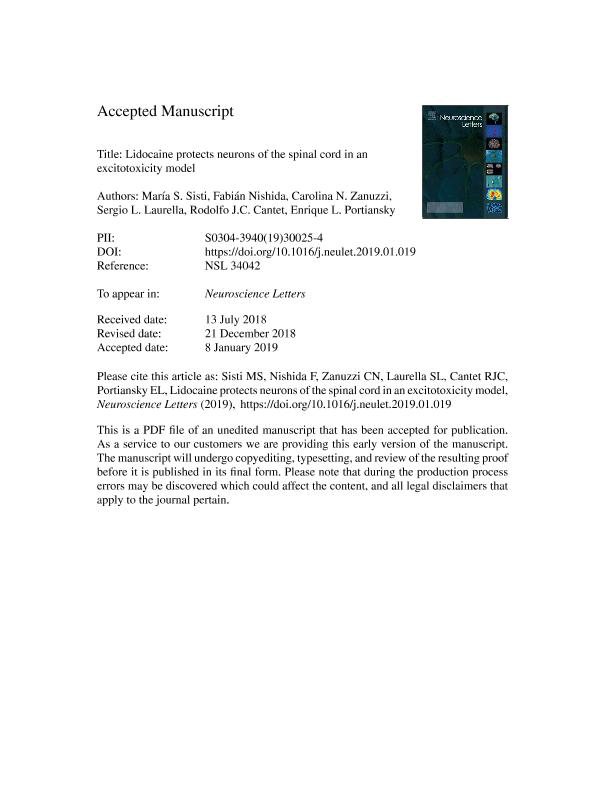Artículo
Lidocaine protects neurons of the spinal cord in an excitotoxicity model
Sisti, María Susana ; Nishida, Fabian
; Nishida, Fabian ; Zanuzzi, Carolina Natalia
; Zanuzzi, Carolina Natalia ; Laurella, Sergio Luis
; Laurella, Sergio Luis ; Cantet, Rodolfo Juan Carlos
; Cantet, Rodolfo Juan Carlos ; Portiansky, Enrique Leo
; Portiansky, Enrique Leo
 ; Nishida, Fabian
; Nishida, Fabian ; Zanuzzi, Carolina Natalia
; Zanuzzi, Carolina Natalia ; Laurella, Sergio Luis
; Laurella, Sergio Luis ; Cantet, Rodolfo Juan Carlos
; Cantet, Rodolfo Juan Carlos ; Portiansky, Enrique Leo
; Portiansky, Enrique Leo
Fecha de publicación:
17/04/2019
Editorial:
Elsevier Ireland
Revista:
Neuroscience Letters
ISSN:
0304-3940
e-ISSN:
1872-7972
Idioma:
Inglés
Tipo de recurso:
Artículo publicado
Clasificación temática:
Resumen
Motor Neuron Disease disorders, described in domestic animals, are characterized by neuronal degeneration at the spinal cord. Excitotoxicity is a crucial factor for the selective loss of these neurons, being the fundamental processes involved in lesion progression after spinal cord injury, where glutamate is one of the main neurotransmitters involved. Kainic acid (KA) resembles the effects induced by the pathological release of glutamate. Lidocaine administered by different routes exerts some neuroprotective effects in the CNS. The aim of the present work was to determine whether lidocaine simultaneously injected with KA into the spinal cord could prevent the excitotoxic effects of the latter. Sprague-Dawley rats were injected by intraparenchymal route with KA or with KA plus 0.5% lidocaine into the C5 segment. Sham rats were injected with saline. Animals were motor and sensory tested at 0, 1, 2, 3, 7 and 14 post-injection days and then euthanized. Sections of the C5 segment were used for histological and immunohistochemical analysis. No KA-induced motor and sensitive impairments were observed when lidocaine was simultaneously injected with KA. Moreover, neuronal counting was statistically higher when compared with KA-injected animals. Thus, lidocaine could be considered as a neuroprotective drug in diseases and models involving excitotoxicity.
Archivos asociados
Licencia
Identificadores
Colecciones
Articulos(CCT - LA PLATA)
Articulos de CTRO.CIENTIFICO TECNOL.CONICET - LA PLATA
Articulos de CTRO.CIENTIFICO TECNOL.CONICET - LA PLATA
Articulos(INPA)
Articulos de UNIDAD EJECUTORA DE INVESTIGACIONES EN PRODUCCION ANIMAL
Articulos de UNIDAD EJECUTORA DE INVESTIGACIONES EN PRODUCCION ANIMAL
Citación
Sisti, María Susana; Nishida, Fabian; Zanuzzi, Carolina Natalia; Laurella, Sergio Luis; Cantet, Rodolfo Juan Carlos; et al.; Lidocaine protects neurons of the spinal cord in an excitotoxicity model; Elsevier Ireland; Neuroscience Letters; 698; 17-4-2019; 105-112
Compartir
Altmétricas



